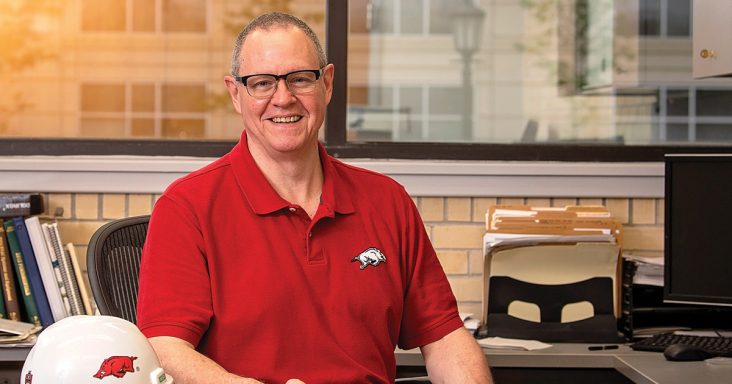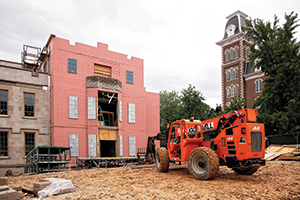Scott Turley oversees UA facilities, multiple construction projects
by June 14, 2021 11:24 am 1,546 views

Scott Turley started May 1 as associate vice chancellor for facilities at the University of Arkansas.
Scott Turley recently was named associate vice chancellor for facilities at the University of Arkansas in the wake of a surge in enrollment and construction projects. While both are expected to moderate, construction projects will continue to maintain a presence on campus.
Turley’s predecessor, Mike Johnson, was responsible for supervising the most extensive and prolonged construction campaign in the university’s history, totaling more than $1.9 billion in value. Johnson retired in March after serving in the position for 17 years. Turley, who’s worked at the UA for 28 years, was named interim associate vice chancellor for facilities in January. He started May 1 in Johnson’s former role.
“It’s an exciting opportunity,” Turley said. “I’m honored that they gave it to me or considered me for it. Mike’s a pretty incredible individual. As I’ve told others, he kind of casts a big shadow to follow in his footsteps, but he also gave me a lot to build off. I’m looking forward to the challenge.”
Turley, who’s 60, said new construction projects likely would not come at the same pace as experienced over the past 15 years when enrollment increased from about 18,000 to more than 27,000 students.
“I think we are coming out of a physical growth period as well as a student enrollment growth period,” he said. “I think our role coming up here in the next decade is going to be more of consolidation [and] caretaking of the things that have been done … I think that aggressive growth that we saw over that period of enrollment growth won’t be the same.”
Turley now oversees some of the UA’s most notable projects, including the $45 million Student Success Center and the 154,600-square-foot Windgate Studio and Design Center. VCC of Little Rock is the general contractor for the former, which is expected to be completed this fall, while Little Rock-based Clark Contractors is the general contractor for the latter, which is on schedule to open in fall 2022.
Significant projects in the works include the $89 million Institute for Integrative and Innovative Research (I3R) Facility, the $20 million Anthony Timberlands Center for Design and Materials Innovation, and renovation of the fine arts building, which Edward Durell Stone designed in the early 1960s.
“It’s ready for a good inside-out facelift,” Turley said. “Once the Windgate facility is finished, we can move people out of that building into the Windgate facility, and that will free that facility up for us to work on.”

The Windgate Studio and Design Center at Martin Luther King Boulevard and Hill Avenue in south Fayetteville will anchor the Windgate Art and Design District. The Anthony Timberlands Center for Design and Materials Innovation will also be built there. The center will include classroom and studio space for the UA’s Fay Jones School of Architecture and Design and house the school’s graduate program with a concentration in integrated wood design. Turley said the center is being designed, and construction is expected to start in summer 2022. The UA selected Nabholz Corp. as the general contractor.
The multidisciplinary I3R Facility at North Duncan Avenue and West Dickson Street will be completed sometime in 2023. The project is transitioning from schematic design to design development, Turley said. Construction will start in late 2021 or early 2022.
Mixed Issues
Asked about the rising cost of materials, especially lumber, Turley explained the challenges. Projects have built-in escalation funds, but the challenge is when construction prices rise above normal inflation levels. Sometimes additional resources are available to cover the increase, or the UA can modify the project to maintain its budget. Another challenge is the length of time that bid prices are honored. Typically, the prices are good for 90 days, but that can also be as short as seven days because of market volatility, he said.
While the high cost of materials, especially wood, are short-term challenges, the UA has committed to using timber for projects over the long term, Turley said. He highlighted the economic benefits of wood, the support for the industry in the state and the UA’s research to develop timber technology, such as cross-laminated timber.
Regarding COVID-19, Turley noted its limited impact on projects. For example, the bulk of the construction on the Student Success Center took place last year.
“It is one of the things that seem to be immune from the impact of COVID,” he said. “Construction activity, interestingly, was not impacted as much as you might think from COVID. Our contractor partners had to take many steps to try to make sure their staff was safe, and they did so. We did the same thing in terms of our interactions with them, so all of the normal things with masking and sanitary practices in terms of handwashing and having different things available there on the worksite.”
Overall, Turley said, existing campus facilities are in good shape, reflecting the work of staff and his predecessor. Also, Turley pointed to the facility fee established about a decade ago under former Chancellor David Gearhart that’s helped the university maintain its educational facilities.
“The facility fee has had a transformational impact on campus of reducing deferred maintenance, and it continues to have a good impact,” he said. “There are a few buildings left that are still in the facility fee program to be addressed.”
They include the agriculture building, fine arts building, and John A. White Jr. Engineering Hall. They will be renovated over the next three to five years.
Background, Goals
Turley is a Pine Bluff native who earned a bachelor’s degree in mechanical engineering from the UA in 1984. He spent nine years as an engineer for International Paper in Pine Bluff before starting at the UA in 1993. His career began as an energy engineer in utilities. More recently, he worked in plant operations alongside maintenance staff and capital planning for utility infrastructure projects.
Before being named to the interim position, he served as executive director for campus utilities and building climate services for about 20 years. Responsibilities included energy procurement and supply, operating a district utility system that makes steam and cooled and heated water, and managing a power distribution grid on campus. He also managed building controls and had HVAC responsibilities.
Of the $1.9 billion in overall campus projects in the past 15 years, Turley said about $50 million could be attributed to utilities. The utility department has increased efficiency and reinvested the savings into utility system improvements. In 2015, the UA installed a combined heat and power plant that provides electricity and heating for campus facilities.
As associate vice chancellor for facilities, Turley’s goals include completing several projects he expects will be transformative for the university, including the I3R Facility, Anthony Timberlands Center for Design and Materials Innovation, and the unprecedented investments into art facilities and education. The UA’s School of Art was established in fall 2017 with a $120 million gift from the Walton Family Charitable Foundation. Later that year, the Windgate Charitable Foundation gave $40 million to create the Windgate Art and Design District. In July 2020, the Walton Family Charitable Foundation announced a $194.7 million grant to support several initiatives, including the I3R Facility.
Meanwhile, Turley’s handling the duties of his former role as he learns his new position. He said the opportunity to make a difference led him to pursue the job.
“Scott’s nearly 30 years of experience and dedication to the care of our campus makes him a natural choice for this role,” said Ann Bordelon, vice chancellor for finance and administration. “His leadership as interim helped advance the critical mission of keeping our facilities and grounds updated, safe, sustainable and beautiful as we begin the transition back to full on-campus operations.”
